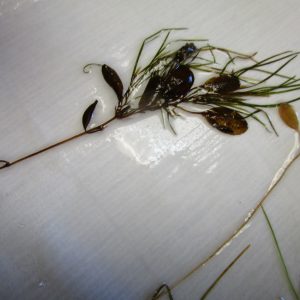
A little saxifrage in Chugach State Park, just outside of Anchorage. The lake below was still frozen at the beginning of June
I was skeptical that my first real week in the field would begin June 11. Doesn’t that seem late? When I left Colorado at the end of April the trees were out to play and flowers had begun to poke their colorful little heads out. Well, it snowed on us during our first day of field work. The temperature didn’t rise much above 50 degrees for the entire week. Most days had a bit of ice and frost in the morning. So, in retrospect, I’m glad I wasn’t out much earlier than this. It seems like winter can hack as far as it wants into the short summer in Alaska. The project lead kept saying “if summer doesn’t come, people get pissed.” Its mid-June and most of the plant haven’t completely leafed-out yet. Apparently its a real possibility that a true summer can skip these parts.
I drove up to Fairbanks for this three-week project on Placer Mine restoration. Fairbanks is one of the northernmost cities in the world. These days, the sun is up nearly 22 hours a day and it never gets totally dark. The name of the borough (Alaska has these instead of counties) is the Fairbanks-North Star borough. Something about this name is quite pretty and poetic to me.

Nome Creek. This area of the stream was mined sometime in the early 2000’s. The white mountains are in the background.
I hadn’t heard of placer mining before coming up here. Chances are, you haven’t either. Gold lives in the bottoms of rivers in the Alaskan interior. Where there’s gold, there’s development. Placer mining reroutes entire rivers, dredges out their historic channel, and sifts through all that material for gold. Sometimes the mining companies will return the river to its historic channel when they are finished. Sometimes they will restore the habitat. Sometimes they wont. Currently, most placer mining companies can only actively mine a small area of land, say, 5-acres. Before they move on to a new area in their lease, they need to restore these five acres. Our four person crew is collecting data on sites that have been restored after mining with various treatments, and comparing those different treatments to control sites and sites that haven’t been restored at all. This project will eventually influence BLM policy on how placer mining restoration should be conducted.

The forest around Nome creek burned in 2004 in a 500,000 acre wildfire. These are the haunting skeletons of thousands of black spruce trees.
Two of the people on my crew are men who work for the Soil and Water Conservation District in Delta, a community east of Fairbanks. They have been in this area for decades and have a great grasp on the general ecology of the place. Jeff is an excellent birder. He has helped me learn the calls for most of the birds we encountered during our first week. I quickly noticed that he was always passively listening for birds, even when in conversation. He knew all the species that were around, and in what abundance. I got my binoculars on some new lifers, including the Northern Hawk Owl, Blackpoll Warbler, Grey-cheeked thrush, and Fox Sparrow.

Crossing Nome Creek on the way out of our field site.
Bryan, the other ecologist, focuses on wetlands. When prompted, he will give long discourses on the permafrost, soil layers, and strange the phenomena that ice creates in the Arctic. Renee is a grad student in entomology. She spent time collecting and finding bugs in all sorts of ways, including Winkler samples, bee bowls, and general searches. It turns out we all play music, so we made some nice tunes to wind down after long days of work. Together, we conducted LPI, counted small and large mammal scat, recorded bird observations, collected insects, diagrammed and collected soil layers, assessed animal browse, measured downed wood and snags, conducted pollinator observations, trapped small mammals, and summarized the flora of each site along Nome Creek. Most of these assessments were new to me. I enjoy the concept of taking data on such a wide array of flora, fauna, and abiotic factors in an ecosystem because it helps get a picture of the entire community rather than just a part of it. Working with this team of highly tuned-in ecologists is educational and goofy at every opportunity.
Next week we head up to the Brooks Range to do the same surveys. I’ll get to be north of the Arctic Circle on the summer solstice, which means a halo of sunshine all 24 hours of the day. 14-hour work days go surprisingly quick with this amount of sunshine because I can never tell what time it is. The week after that we head a little south to the Denali highway for another week of surveys. I’m looking forward to spending two more weeks with these folks, and two more weeks in the North Star.

Somewhere in the millions of miles of boreal forest…














































